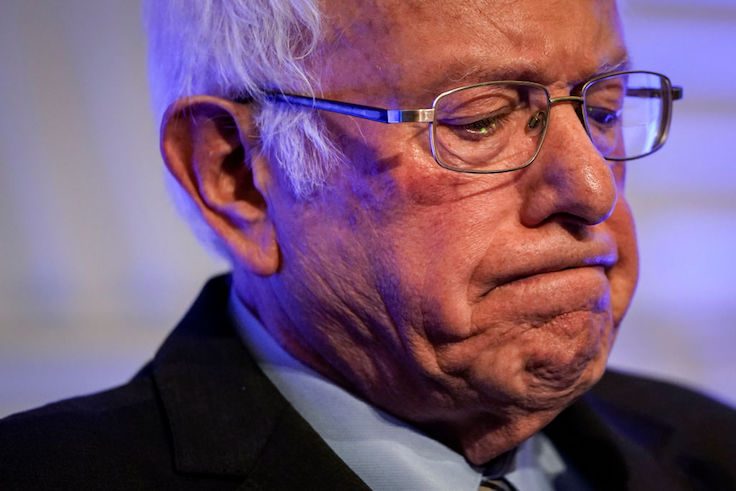Facing mounting pressure to explain how he will raise enough revenue to cover the largest peacetime budget in American history, Sen. Bernie Sanders (I., Vt.) in advance of Tuesday evening's debate released a plan outlining how he will pay for his proposals.
The plan, which debuted Monday evening, projects additional revenue of more than $37 trillion over the next 10 years, the product of a cross-section of aggressive new taxes on everyday Americans as well as the top percentile of earners. That figure pales in comparison to the tens of trillions Sanders expects to spend over the next 10 years, leaving a substantial budget shortfall even under the rosiest of assumptions.
Sanders, the current frontrunner for the Democratic nomination, released his plan the day before the South Carolina Democratic debate amid increasing scrutiny. Although the plan partially addresses critics' charges that Sanders has been evasive on how he will pay for his proposals, it also opens up new lines of attack, allowing moderate opponents to charge him not only with excessive spending but also financial irresponsibility.
In total, the plan covers seven major components of Sanders's agenda: Medicare for All, a Green New Deal, universal college and canceling student debt, universal pre-k, universal public housing, expanding Social Security, and eliminating medical debt. Its $37 trillion of added tax revenue reflects a bevy of old proposals—especially Sanders's wealth tax—as well as new details on, for example, Sanders's projected revenue from Green New Deal jobs.
Although prodigious, the total sum Sanders plans to raise would fall short of his full spending goals. A CNN analysis pegged Sanders's total spending at $60 trillion, substantially larger than any prior peacetime administration. An analysis from the left-leaning Progressive Policy Institute estimated the cost of Sanders's plans at roughly $47.8 trillion—still well short of what he plans to raise. Sanders's campaign did not respond to a request for comment on this and other disparities.
Even under Sanders's most optimistic assumptions, massive shortfalls remain. For example, the campaign indicated that it expects to bring in $4.35 trillion per year from the wealth tax. But the right-leaning Tax Foundation estimates that it will only bring in $3.2 trillion per year, due to higher rates of tax avoidance. That would leave Sanders with $10 trillion less over a decade than he expects.
Much of the measurable shortfall is attributable to Sanders's cost assumptions about Medicare for All. The campaign offers methods to raise $17.5 trillion, citing research from Yale epidemiologists arguing that that total is the amount of added government spending needed to cover Medicare for All. But that figure falls well short of standard projections of around $2.5 to $3.6 trillion in added costs per year—a figure Sanders himself has cited. In other words, only by lowballing the cost of the largest health care program in American history can Sanders credibly claim to have outlined a way to pay for his plan.
Sanders also outlines his plans to pay for a $16.3 trillion Green New Deal that would substantially overhaul American homes, vehicles, and communities without funding carbon capture and alternative energy technologies. To pay for the proposal, Sanders's plan would not only tax fossil fuels and increase the corporate tax rate, but would also cut military spending $1.2 trillion "by scaling back military operations on protecting the global oil supply."
Of the expected revenues, $10 trillion comes either from income taxes on wages from jobs Sanders expects the Green New Deal will create, lower safety net spending thanks to those jobs, or the sale of electricity by publicly owned power utilities. These benefits, however, might be outweighed by the economic costs of a Green New Deal.
"While there may be some gains from eliminating duplicate spending (e.g., safety net duplications under Medicare for All and the job guarantee), there would be an equal or greater than equal offsetting decrease in revenue from reductions in the tax base," Garrett Watson, senior policy analyst at the Tax Foundation, told the Washington Free Beacon. "The same source of tax revenue is taxed multiple times in his plan, which has an interaction effect that lowers the revenue that can be gained from the entirety of his plan. Overall, the sum of each component tax is likely an upper bound for what can be raised realistically."
Until this point, Sanders has been mum on how he would pay for many of his proposals. In so doing, he has avoided the fate of fellow 2020 contender Sen. Elizabeth Warren (D., Mass.), who in November released a widely panned explanation of how she would pay for Medicare for All. That plan, alongside Warren's eventual announcement that socialized health care would be phased in with a public option, likely contributed to the Warren campaign's sinking fortunes.
